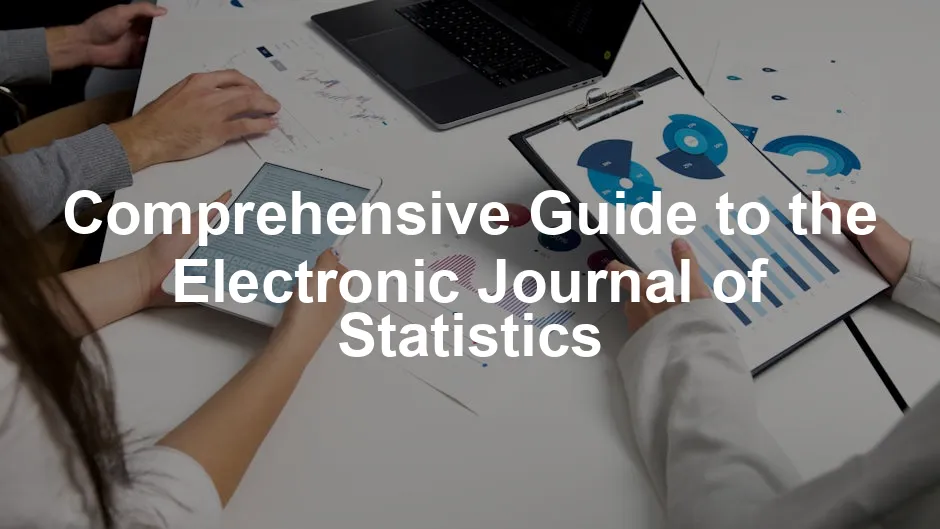Introduction
The Electronic Journal of Statistics (EJS) is a shining star in the realm of statistical research. As an open-access, peer-reviewed publication, it serves as a beacon for statisticians and researchers worldwide. Established to enhance the spread of statistical methodologies, the EJS plays a crucial role in making cutting-edge research accessible.

The EJS serves as a crucial platform for sharing statistical research. statistical research inc
This journal is a collaborative effort between the Institute of Mathematical Statistics and the Bernoulli Society, uniting two prestigious entities in the field. Their partnership emphasizes the importance of fostering innovation and knowledge-sharing in statistics. By embracing an open-access model, the EJS ensures that articles reach a broad audience, allowing those who may not have institutional access to benefit from the latest findings. If you’re looking to dive deeper into the world of statistics, check out Statistics for Dummies. This book is perfect for those who find numbers daunting.
In an era where data-driven decisions are paramount, the EJS stands out by promoting the development and dissemination of statistical applications. It provides a platform for researchers to share their work, contribute to ongoing discussions, and inspire future inquiries. With its commitment to quality and transparency, the journal plays a vital role in the statistical community, ensuring that valuable insights are not locked behind paywalls. Whether you’re an academic, a practitioner, or just someone curious about statistics, the EJS has something to offer you.

Overview of the Electronic Journal of Statistics
History and Foundation
Founded in 2007, the Electronic Journal of Statistics emerged as a response to the growing demand for open-access scholarly communication in statistics. This journal has grown alongside the open-access movement, which champions the free dissemination of research. By removing barriers to access, the EJS has made significant strides in promoting statistical research.
The journal’s mission revolves around enhancing the visibility and impact of statistical methodologies. It aims to support both theoretical advancements and practical applications, making it a versatile platform for researchers from various domains. With a commitment to excellence, the EJS ensures that all articles undergo rigorous peer review, upholding the same standards as traditional journals.
Through its history, the EJS has established itself as a reliable source of knowledge. Researchers seeking to publish their findings can do so with confidence, knowing their work will be scrutinized and valued. The continuous evolution of the journal reflects the dynamic nature of the statistical field, adapting to new challenges and opportunities as they arise. If you’re looking to enhance your statistical analysis skills, consider picking up R for Data Science. This book is a fantastic resource for anyone looking to dive into data analysis.

Journal Characteristics
The Electronic Journal of Statistics publishes a diverse range of content. This includes research articles, short notes, and contributions from theoretical, computational, and applied statistics. Each submission is evaluated thoroughly, ensuring that only high-quality research is showcased.
The EJS publishes a wide range of articles, including those related to applied statistics. master of science in applied statistics for social science research
One of the standout features of the EJS is its open-access model. This approach means that all articles become publicly available shortly after acceptance, allowing for rapid dissemination of research findings. The journal operates under a Creative Commons Attribution 4.0 license, which encourages sharing and reuse of published work. Authors can publish without worrying about hefty fees, as the EJS does not require author or publication fees. However, voluntary contributions to support the journal are welcomed.
In summary, the EJS embodies a commitment to accessibility and quality in statistical research. Its collaborative foundation, diverse content offerings, and dedication to open access make it a vital resource for researchers and practitioners alike. As the field of statistics continues to grow and evolve, the EJS remains at the forefront, facilitating the sharing of knowledge and the advancement of methodologies. And if you’re in need of a good read while you’re at it, grab a copy of The Elements of Statistical Learning. It’s a classic that every statistician should have on their shelf.

Publication Process
Submission Guidelines
Submitting a manuscript to the Electronic Journal of Statistics (EJS) is a streamlined process. Authors must prepare their manuscripts using LaTeX, employing the EJS template specifically designed for this purpose. This template ensures that all submissions maintain a consistent format, which is crucial for the review process. Once the manuscript is ready, it must be converted into a PDF file. For those new to LaTeX, I recommend checking out LaTeX for Dummies, which makes it easy to get started!
Next, authors will submit their papers electronically through the EJS submission platform. New users must register first, but don’t worry! Registration is a one-time affair. If authors already have a profile from submitting to another journal, they can simply add EJS author access to their existing account. To make things even easier, authors can suggest potential referees for their papers, which can help expedite the review process.
As for the types of papers accepted, the EJS welcomes a broad range of submissions. This includes research articles and short notes covering theoretical, computational, and applied statistics. Authors are encouraged to write in a style similar to that found in leading statistical journals, like The Annals of Statistics or The Journal of the American Statistical Association. The key is clarity. Abstracts and introductions should be straightforward, ensuring accessibility for a wide audience.

Review Process
The EJS takes the peer-review process seriously, upholding high standards for publication. Once a manuscript is submitted, it is assigned to an Editor, who then allocates it to an Associate Editor. This editor manages the review process, ensuring that the manuscript receives fair and thorough evaluation.
Reviewers are selected based on their expertise in the subject matter. They provide critical feedback, which may involve suggesting revisions. The goal is to enhance the quality of the research before publication. The editorial board plays an essential role in overseeing these processes. They ensure that all manuscripts adhere to the journal’s rigorous standards, maintaining the integrity and reputation of the EJS.
Publication Timeline
Once a manuscript is accepted, authors can expect a quick turnaround. The average timeline from submission to publication is approximately six weeks. This efficiency is a hallmark of the EJS and reflects its commitment to timely dissemination of statistical research. Authors can rest assured that their work will not languish in limbo; instead, it will be shared with the academic community swiftly, allowing for impactful discussions and further research in their fields. If you’re looking to boost your data analysis skills further, consider Python for Data Analysis. This book is a fantastic resource for anyone working with data.

Editorial Board and Contributors
Current Editorial Board
The current editorial board of the Electronic Journal of Statistics is a distinguished group of experts in the field of statistics. Leading the charge are Editors Grace Y. Yi and Gang Li, who serve terms from 2022 to 2024. Their extensive backgrounds in statistical research equip them to guide the journal effectively.
The Associate Editors include a plethora of talented individuals, each contributing their unique expertise. Notable members are Christophe Andrieu, Jianxin Pan, Ery Arias-Castro, and Victor Panaretos, among others. Each editor brings a wealth of knowledge and experience, ensuring that the EJS remains at the forefront of statistical research. Their contributions help maintain the journal’s reputation for publishing high-quality work that advances the field of statistics. For those looking to broaden their knowledge, consider reading Practical Statistics for Data Scientists. This book offers valuable insights for those in the field.

In conclusion, the EJS is not just a platform for research; it is a community of scholars dedicated to the pursuit of statistical excellence. By fostering a rigorous peer-review process and maintaining an editorial board rich in expertise, the journal continues to play a vital role in the development and dissemination of statistical methodologies. Whether you are a seasoned researcher or a newcomer, the EJS offers an inviting space for sharing and advancing statistical knowledge.
Past Editors and Contributions
The Electronic Journal of Statistics (EJS) has seen several notable past editors who have shaped its reputation. One of the most prominent figures is Domenico Marinucci, who served as the editor-in-chief for several years. His expertise and vision helped cultivate a rich environment for statistical research. Under his guidance, the journal expanded its reach and drew in high-quality submissions.
Another influential editor was George Michailidis, known for his contributions to statistical methodologies. His tenure saw the journal produce groundbreaking research that addressed complex statistical challenges. These editors set high standards for the publication, ensuring that only rigorous and innovative work made it to print.
Their influence is evident in the journal’s commitment to excellence. The editorial leadership has always prioritized a meticulous review process, attracting well-respected researchers. The legacy of these editors continues to inspire new submissions and maintain the journal’s esteemed position in the statistical community. If you want to explore the foundations of statistical learning, I suggest reading Introduction to Statistical Learning. It’s an excellent resource!

Impact and Metrics
Impact Factor and Ranking
The Electronic Journal of Statistics (EJS) boasts a current impact factor of 0.986 and a five-year impact factor of 1.281. These numbers indicate a steady growth trajectory, reflecting the journal’s increasing visibility and relevance in the field. EJS ranks #68 out of 123 journals in the Statistics and Probability category, solidifying its status as a reputable publication. This ranking highlights its competitive edge among peers, making it a sought-after platform for statisticians.
The impact factor measures the average number of citations to recent articles, showcasing the journal’s influence. A strong impact factor can attract more submissions, as researchers aspire to publish in well-cited venues. Thus, EJS’s solid standing is not just a number; it resonates with the journal’s commitment to fostering impactful statistical research.
Citation Metrics
In terms of citation metrics, the EJS has accumulated a total of 499 citations in the past year. This equates to about 1.332 cites per document, indicating a healthy engagement with the published research. These metrics are crucial in evaluating how well the journal contributes to the academic discourse. They provide insights into how frequently the articles are referenced in other works, demonstrating the journal’s relevance in statistical discussions.
Collaboration statistics further illuminate EJS’s impact. The journal has seen 27.66% international collaboration among authors, fostering a global exchange of ideas. This diverse authorship enriches the quality of research published and broadens the perspectives represented within its pages. Furthermore, the percentage of female authors stands at 24.89%, reflecting ongoing efforts towards inclusivity in the field. And speaking of inclusivity, if you’re looking to enhance your productivity, check out the Ergonomic Office Chair. It’s a game-changer for those long study sessions!
These citation metrics serve as vital indicators of the journal’s academic influence. They help researchers assess where to publish their work and guide institutions in their evaluations. As EJS continues to grow, its impact on the statistical community remains significant, encouraging further exploration and innovation in statistical methodologies.

Current and Featured Content
Current Issue
The current issue of the *Electronic Journal of Statistics* (EJS) highlights an impressive line-up of articles that appeal to various statistical interests. This edition, released in January 2024, includes five remarkable contributions that showcase the breadth of contemporary statistical research.
One standout article, “Wasserstein and Total Variation Distance Between Marginals of Lévy Processes” by Ester Mariucci et al., explores the nuanced relationship between probability distributions, offering fresh insights relevant to both theoretical and applied statistics. Another intriguing piece, “Combining Predictive Distributions” by Tilmann Gneiting et al., dives into the fascinating world of predictive modeling, emphasizing the importance of accuracy in forecasts.
The issue also features “Generalized Bayesian Likelihood-Free Inference” by Lorenzo Pacchiardi et al., which discusses advanced methodologies for Bayesian inference without the need for likelihood functions. “Beyond Sigmoids: How to Obtain Well-Calibrated Probabilities from Binary Classifiers with Beta Calibration” by Meelis Kull et al. presents innovative approaches for improving the calibration of predictive models. Lastly, “On the Conditions Used to Prove Oracle Results for the Lasso” by Sara A. van de Geer et al. examines the conditions necessary for successful application of the Lasso method in statistical modeling.

This diverse collection not only highlights the journal’s commitment to covering a wide range of topics but also ensures that readers have access to cutting-edge research that can inform their own work. If you’re interested in learning more about data visualization techniques, make sure to check out Data Visualization: A Practical Introduction. It’s a great resource for transforming data into visual stories!
Notable Past Articles
Over the years, the EJS has published numerous impactful articles that have significantly advanced the field of statistics. One of the most cited papers is “Generalized Bayesian Likelihood-Free Inference” published in 2024, which has influenced how researchers approach Bayesian methodologies.
Another essential contribution, “Combining Predictive Distributions”, has become a cornerstone reference for statisticians interested in enhancing predictive models. This article’s insights into the combination of predictive distributions have been widely adopted in various statistical applications.
Further, the paper “Beyond Sigmoids” has generated considerable interest due to its practical implications for machine learning practitioners aiming for well-calibrated probabilities. Its methodology has been applied across numerous domains, demonstrating the journal’s role in bridging theoretical research and practical applications. And for those wanting to explore statistical inference, I recommend Statistical Inference. It’s a great addition to your library!

These notable articles exemplify the EJS’s dedication to publishing high-quality research that resonates within the statistical community, fostering continued innovation and exploration in the field.
Open Access and Funding
Open Access Model
The *Electronic Journal of Statistics* operates under an open-access model, meaning that all articles are freely available to everyone, everywhere. This approach significantly enhances the visibility and accessibility of research findings, allowing scholars, practitioners, and curious minds alike to benefit from the latest advancements in statistics without any financial barriers.
By eliminating paywalls, the EJS democratizes knowledge. Readers can easily access a wealth of information that would otherwise remain confined to those with institutional subscriptions. This model not only benefits individual researchers but also promotes collaboration and knowledge-sharing across the global statistical community.
To support this open-access endeavor, the journal welcomes voluntary fees and donations. These contributions help cover operational costs and ensure the sustainability of the journal. While the EJS does not impose mandatory publication fees on authors, voluntary donations to the Open Access Fund are greatly appreciated. This funding mechanism enables the journal to maintain its high standards of peer review and publication quality.
The EJS’s commitment to open access not only aligns with the evolving landscape of academic publishing but also resonates with the broader goals of making scientific research universally accessible. By fostering a culture of openness, the EJS plays a pivotal role in advancing statistical knowledge and practice. And if you’re looking to stay organized while you work, consider a Desk Organizer. It can help keep your workspace tidy!

Funding and Publication Charges
While the EJS does not require authors to pay publication fees, it does have a voluntary article processing charge (APC) of $675. This fee is not compulsory; however, it helps sustain the journal’s operations and ensures that quality research continues to be published without barriers.
Many institutions offer funding opportunities to support authors in covering these charges. Researchers affiliated with universities often find that their institutions have dedicated funds for open-access publications. It’s advisable for authors to check with their institution’s library or research office to explore available funding options.
The journal’s funding structure is designed to promote inclusivity, enabling a diverse range of voices in the statistics field to publish their work without financial constraints. As the landscape of academic publishing evolves, the EJS remains committed to fostering open access while encouraging contributions that enhance its sustainability.

Conclusion
The Electronic Journal of Statistics plays a pivotal role in the realm of statistical research. As an open-access, peer-reviewed journal, it fosters innovation and dissemination of methodologies that can impact various fields. By eliminating paywalls, the EJS ensures that groundbreaking research is accessible to all, promoting collaboration among statisticians globally.
Through its rigorous peer-review process and commitment to quality, the EJS has established itself as a reputable platform for scholars. It serves as a vital resource for researchers, practitioners, and anyone curious about statistical applications. The diverse range of articles published in the journal reflects the dynamic nature of the field and the importance of sharing knowledge.
Researchers should consider submitting their work to the EJS. It’s an excellent opportunity to reach a broad audience while contributing to the academic discourse. Plus, the resources provided by the journal can help elevate your research to new heights. Whether you’re embarking on theoretical advancements or applied studies, the EJS is ready to showcase your work. If you’re looking for a reliable kitchen companion for your data-driven diet, you might also want to check out the Instant Pot. It’s a versatile kitchen tool!

FAQs
What types of articles can be submitted to the EJS?
The EJS accepts a wide array of submissions, including research articles and short notes. Topics can range from theoretical and computational statistics to applied statistics. Authors are encouraged to write clearly, making their work accessible to a diverse audience.
How long does the review process take?
The review process at the EJS is quite efficient. On average, authors can expect a turnaround time of about six weeks from submission to publication. This speedy process helps ensure that research findings reach the community promptly.
Is it necessary to pay fees for publication?
While the EJS has a voluntary article processing charge (APC) of $675, it is not mandatory. Many authors find funding available through their institutions to cover this fee. Thus, financial constraints should not deter potential submissions.
How can I access articles published in EJS?
Accessing articles in the EJS is straightforward! All published content is open access, meaning anyone can freely read and download articles. Simply visit the journal’s website, and you’re good to go!
Who are the current editors of the journal?
The EJS is led by esteemed editors Grace Y. Yi and Gang Li, who serve terms from 2022 to 2024. They are supported by a talented team of associate editors, including Christophe Andrieu, Jianxin Pan, and Ery Arias-Castro, among many others.
Please let us know what you think about our content by leaving a comment down below!
Thank you for reading till here 🙂
All images from Pexels




